
The trial, which was adjourned on 23 March, resumed today.
Referred back and corona
First of all, the presiding judge referred back to the first series of hearings. He spoke about the restrictions on attendance in court during the current series of hearings owing to corona measures: only a limited number of people can be present in court. The hearings can, however, still be viewed by everyone by livestream.
Correspondence and a provisional agenda
The presiding judge spoke about the correspondence that had taken place between the prosecution, the defence and the court itself. As a result of that correspondence, the court had devised a provisional agenda for the coming weeks.
The case file
Today, the court listed a number of documents that had been added to the case file. These include statements, investigation reports, photos and displays of parts of the investigation. These documents had been added to the files of each of the accused.
Decision of the council chamber of the court
The court also referred to the decision of the council chamber of the court, on an appeal brought by the defence. The defence disagreed with the investigating judge’s decision to grant 13 witnesses the status of threatened witness and to incorporate their statements, without their name on them, in the case file. The judges that compose the council chamber are not the same as the judges that are hearing this case here at the JCS. The council chamber dismissed the defence’s appeal, except in the case of one witness, because in that particular case the defence had, wrongly, not been asked its views on the status of the witness. The consequences of the council chamber’s decision have yet to be ascertained by the court.
The court also addressed the three questions that it had put to the prosecution during the previous hearings.
Questions
The first question concerned the investigation into pin and credit card data from companies in Snizhne, Ukraine, relating to 17 July 2014. According to the prosecution, that investigation had not yielded anything of relevance to the trial. For that reason, no data from that investigation had been added to the case file.
The second question concerned classified satellite images that are said to be in the possession of the United States authorities. The prosecution referred to a memorandum from the United States authorities. That memorandum had been assessed for accuracy by a Dutch public prosecutor specialising in anti-terrorism. Classified information had been shared with the prosecutor on a confidential basis. Based on that information, the prosecutor had concluded that the sources that he had reviewed did indeed support the memorandum and had made a written statement to that effect. That statement had now been entered in the case file. The US authorities had stated that they were unable to provide further information regarding detection of the missile.
The question had also been put as to whether, in addition to the relatives of the occupants of flight MH17, other aggrieved parties had been approached about obtaining compensation. The prosecution reported that it had looked into this matter in various ways, but that no information had been received in this connection. Malaysia Airlines had, however, repeatedly stated that it did not wish to play a role in the criminal proceedings.
Requested
Finally, the court requested that the prosecution address the matter of reports that one of the accused had been arrested, and the recent interview by another accused person.
The defence
The defence then took the floor. In brief, the defence expressed its concerns about its ability to present a robust defence. It reported, notably, that it was unable to contact its client directly. The defence said that this made it difficult to discuss the case file and to build up a bond of trust with him. The defence stated that, despite the restrictions, it would do its best to submit its requests for further investigative measures.
The court will address the statements made by the defence and the prosecution’s response to them later in the proceedings.
The prosecution
The prosecution then commenced a comprehensive presentation of the investigation. It shed light on the investigation and how it was conducted. That information will notably enable the defence to determine better which investigative measures it wishes to request. It is expected that the presentations on the investigation will take several days. The prosecution would take questions on the substance of its presentations after the court’s Day in Court session.
After the prosecution’s presentations, as things stand, the court will adjourn and hearings will resume again on 22 June. At that point in time, the defence will have the opportunity to state what investigative measures it would like to be taken.
